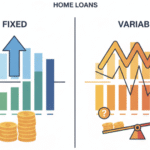Buying your first home in Australia feels like navigating a minefield. With median house prices hitting $1.02 million nationally and fierce competition from investors, first-time buyers face unprecedented challenges. Yet many stumble over preventable mistakes that cost thousands of dollars and months of frustration.
The stakes couldn’t be higher. Current data shows 61% of first-home buyers have missed out on at least one property they seriously considered, with 20% missing out on three or more properties. Meanwhile, mortgage stress affects 27.9% of mortgage holders as of August 2025 – that’s over 1.4 million Australians struggling with repayments.
Understanding these common traps can save you from joining these statistics. Here’s what goes wrong most often and how to avoid these costly errors.
Financial Planning Blunders That Cost Big
Starting House Hunting Without Pre-Approval
Walking into open homes without loan pre-approval ranks as the biggest time-waster first-time buyers commit. You’ll spend weekends viewing properties outside your budget while serious buyers with pre-approval secure deals around you.
APRA’s current lending standards require borrowers to prove they can service loans at interest rates 3.0 percentage points above the actual rate. This serviceability buffer protects you from rate rises but often means your actual borrowing capacity sits lower than expected.
Real estate agents and sellers favour buyers who demonstrate financial readiness. When multiple offers land on the same property, pre-approved buyers hold significant advantages in negotiations. Without this documentation, your offers carry less weight regardless of how much you’re willing to pay.
Action step: Contact lenders or mortgage brokers before viewing any properties. Formal pre-approval clarifies your genuine buying power and positions you as a serious contender when making offers.
Underestimating True Purchase Costs
First-time buyers typically focus on deposit requirements and purchase prices while overlooking substantial additional expenses. These hidden costs add 2-5% to your property purchase and include stamp duty, legal fees, inspections, and insurance.
Lender’s Mortgage Insurance (LMI) particularly stings buyers borrowing over 80% of property value. LMI costs range from $6,266 for a $500,000 property with 15% deposit to over $44,000 for a $1 million property with just 5% deposit.
However, the expanded First Home Guarantee Scheme starting October 2025 allows all first-home buyers to borrow with 5% deposits without paying LMI. This represents massive savings but requires meeting specific eligibility criteria.
Stamp duty variations across states create further complexity. Western Australia recently increased concessions, eliminating stamp duty on homes up to $500,000 for eligible first-home buyers.
Action step: Calculate all upfront costs including stamp duty, legal fees, inspections, insurance, and moving expenses. Build these into your budget from day one, not as an afterthought. Use our stamp duty calculator to understand Queensland costs.
Property Selection Mistakes That Haunt Long-Term
Skipping Professional Inspections
Foregoing building and pest inspections ranks among the most expensive shortcuts first-time buyers take. In Australia, termites affect one in three homes during their lifetime, causing approximately $1.5 billion in damage annually.
Professional inspections reveal structural defects, termite infestations, plumbing issues, electrical problems, and water damage that aren’t visible during casual property viewings. These problems can cost tens of thousands to rectify after settlement.
Queensland stands alone in requiring building and pest inspectors to hold qualifications and licences. Other states offer less regulatory protection, making inspector selection more critical. Our building inspection guide covers what to look for when choosing qualified inspectors.
Action step: Always conduct professional building and pest inspections before finalising purchases. Invest in qualified inspectors with appropriate credentials and comprehensive insurance coverage.
Emotional Decision-Making Over Logic
Emotional attachment consistently drives poor buying decisions among first-time purchasers. When buyers fall in love with properties, they’re more likely to overpay significantly, overlook serious issues, rush due diligence, and waive important contract conditions.
Real estate agents exploit these emotional responses through staging, urgency tactics, and psychological pressure. Properties that appear perfect on the surface may hide expensive problems or fail to meet long-term needs.
The current market’s competitive nature amplifies emotional decision-making. With properties receiving 10-20 offers in popular areas, buyers feel pressured to make quick decisions without proper analysis.
Action step: Maintain objectivity by creating predetermined budget limits and requirements checklists. Sleep on major decisions and avoid revealing emotional attachment to agents during negotiations.
Market Research and Location Oversights
Inadequate Neighbourhood Analysis
Many first-time buyers choose properties based on familiarity rather than investment potential or future needs. Failing to research neighbourhood characteristics results in poor capital growth prospects, limited rental demand if circumstances change, and unexpected development impacts.
Location analysis should include local market trends, planned infrastructure developments, employment opportunities, demographic changes, and transport links. Properties in areas with improving infrastructure or employment growth typically outperform those in declining regions. Our Gladstone property market analysis provides insights into local market dynamics.
Action step: Research beyond current convenience factors. Consider both immediate needs and long-term resale potential when evaluating locations.
Misunderstanding Current Market Dynamics
The Australian property market has become increasingly competitive for first-time buyers. Recent market data shows first-time buyers competing directly with returning investors, creating bidding wars on properties under $800,000.
Low housing stock levels combined with the upcoming First Home Guarantee expansion create additional buyer urgency. This competition drives some buyers to make sight-unseen purchases or overpay significantly beyond market value.
Action step: Prepare for competitive processes by having all documentation ready. Consider engaging buyer’s agents for professional representation in high-competition scenarios.
Professional Service and Regulatory Errors
Missing Government Incentives and Support
First-time buyers often miss valuable government assistance programs that could save thousands of dollars. Available schemes include the expanded First Home Guarantee Scheme, state-based First Home Owner Grants typically worth $10,000-$15,000, and varying stamp duty concessions.
The Queensland First Home Owner Grant provides $15,000 for eligible first-time buyers purchasing new homes. Understanding eligibility requirements and application processes prevents missing these valuable benefits.
The First Home Guarantee Scheme expansion removes previous place limits and increases property price caps from October 2025. This allows more buyers to access 5% deposit lending without LMI.
Action step: Research all available federal and state government incentives before purchasing. Our FHOG document checklist helps streamline your application process.
Poor Professional Service Selection
Many buyers engage conveyancers only after signing contracts, missing important pre-contract advice. Wrong legal representation leads to delayed settlements, missed condition deadlines, unidentified title issues, and inadequate buyer interest protection.
Conveyancing mistakes cost buyers time and money through settlement delays and legal complications. Choosing conveyancers based solely on price often results in inexperienced representation when problems arise.
Action step: Engage experienced conveyancers early in the process for pre-purchase contract reviews and advice. Prioritise experience and responsiveness over lowest fees.
Debt Management and Financial Risk Oversights
Overextending on Debt-to-Income Ratios
Australian lenders increasingly scrutinise debt-to-income (DTI) ratios, with many preferring ratios below 6:1. APRA data shows 24% of new mortgage lending had DTI ratios above 6 in late 2021, contributing to current mortgage stress levels.
High DTI ratios increase mortgage stress risk and limit future financial flexibility. With mortgage stress affecting record numbers of households, conservative borrowing becomes more important than maximising purchase power.
Understanding your home loan borrowing capacity helps set realistic property search parameters and prevents overcommitment.
Action step: Maintain conservative DTI ratios well below lender maximums. Factor in potential rate rises and ensure comfortable repayment capacity even during financial pressure.
Ignoring Interest Rate Variability
Many first-time buyers focus on current interest rates without considering potential increases. APRA’s 3% serviceability buffer requires demonstrating repayment capacity if rates rise significantly, but buyers often don’t plan practically for this scenario.
With the RBA having cut rates three times in 2025 to 3.6%, buyers entering the market may face higher rates in future cycles. Historical data demonstrates significant rate volatility over typical property ownership periods.
Our home loan calculator helps model different interest rate scenarios and their impact on your repayments.
Action step: Stress-test your budget against higher interest rates and maintain emergency funds for rate rises and unexpected expenses.
Building Your Deposit Strategy
One critical area where first-time buyers struggle involves saving for a home deposit effectively. Many underestimate the time required to accumulate sufficient funds while property prices continue rising.
Successful deposit saving requires structured approaches, automated savings plans, and often lifestyle adjustments. Government schemes like the First Home Super Saver Scheme allow using superannuation contributions to boost deposit savings, but understanding eligibility and withdrawal processes prevents costly mistakes.
Moving Forward Successfully
Avoiding these common first-time buyer mistakes requires thorough preparation, professional guidance, and disciplined decision-making. Australia’s complex property market, combined with high prices and intense competition, makes expert advice more valuable than ever.
Success comes from securing pre-approval early, understanding total buying costs, conducting proper inspections, maintaining emotional discipline, researching government incentives, and planning for financial variability. With proper preparation and awareness of these pitfalls, first-time buyers can navigate Australia’s challenging property market more successfully while protecting their long-term financial wellbeing.
If you’re considering purchasing your first home, specialist first home buyer loans provide tailored solutions that address these common challenges. Professional mortgage brokers can guide you through the process, helping avoid these costly mistakes while maximising your chances of securing the right property at the right price.
The property market won’t wait for you to learn these lessons the hard way. Start with professional advice, stick to your budget, and make decisions based on facts rather than emotions.



